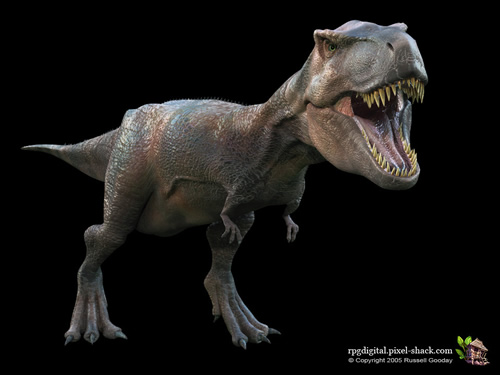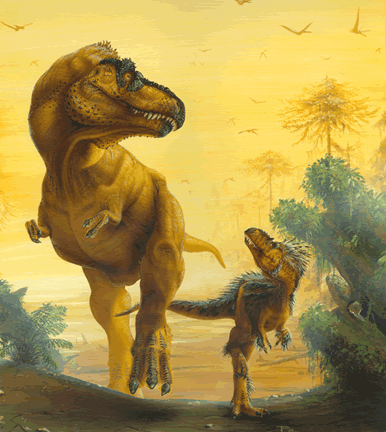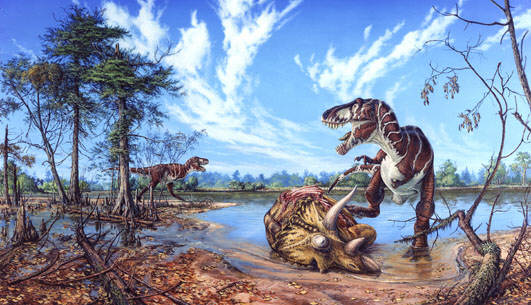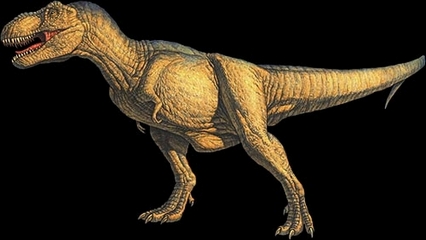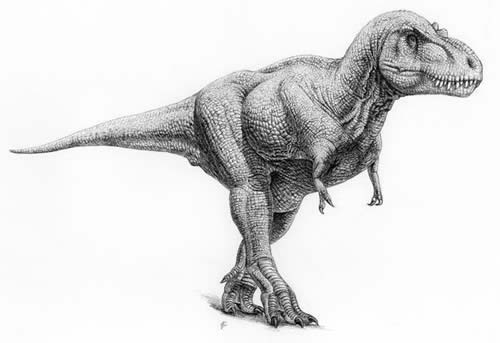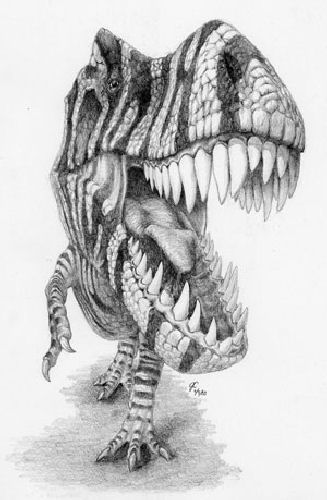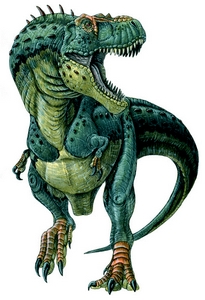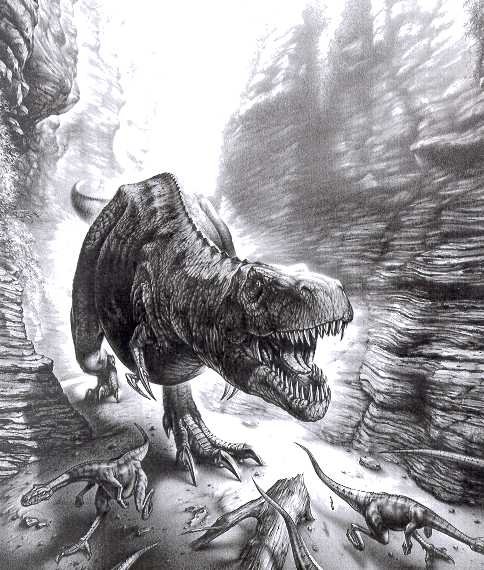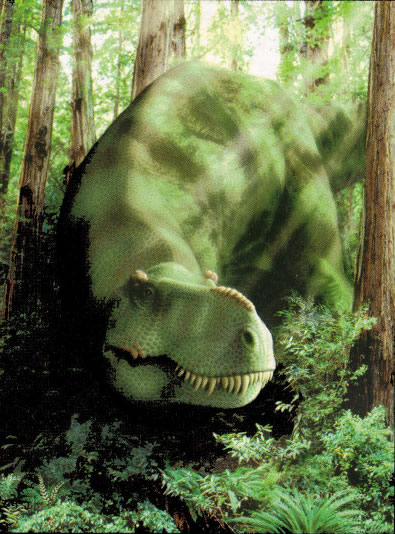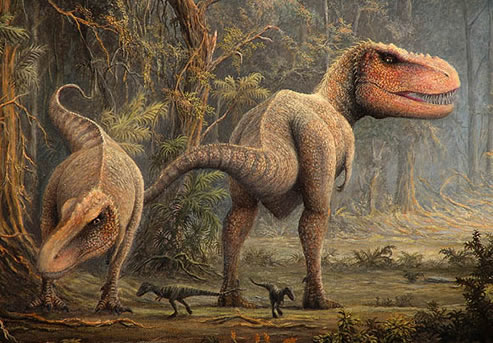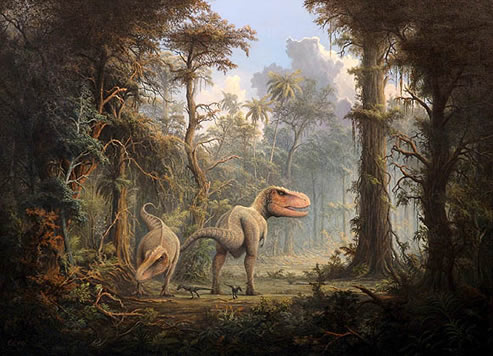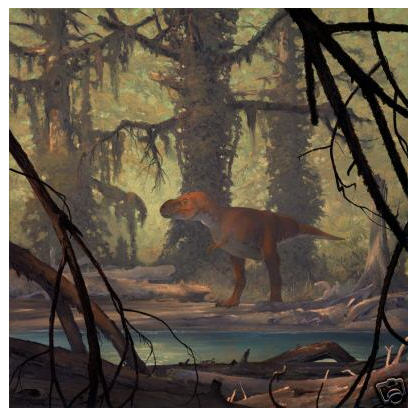Tyrannosaurus rex- Carnivore Dinosaurs
Homepage > Carnivore Dinosaurs - Tyrannosaurus rex
(tye-RAN-uh-SAWR-us)
"tyrant lizard"
Describer Osborn, 1905
Also Known As Manospondylus, Cope, 1892. Dynamosaurus, Osborn, 1905. ?Nanotyrannus,
Bakker, Williams and Currie, 1988. Stygivenator, Olshevsky, 1995. Dinotyrannus,
Olshevsky, 1995.
Type of Species rex
Order Saurischia
SubOrder Theropoda
InfraOrder --
Micro-Order --
Family Tyrannosauridae
Size 40 feet (12 meters) in length
Period Late Cretaceous, 70 million years ago
Fossilsite Scollard Formation, Willow Creek Formation, Alberta, Frenchman
Formation, Saskatchewan, Canada, Hill Creek South Formation, Montana,
Hell Creek Formation, South Dakota, Lance Formation, Wyoming; Javelina
Formation, Texas, McRae Formation, New Mexico, Denver Formation, Colorado
Diet Bipedal Carnivore
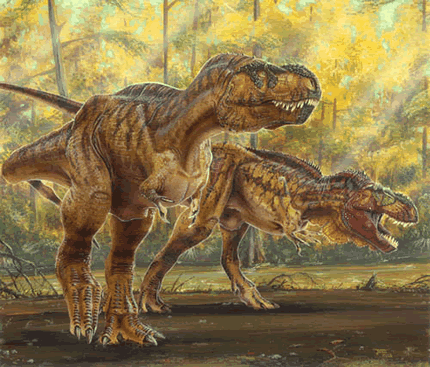 Tyrannosaurus
rex was a fierce predator that walked on two powerful legs. This carnivore
had a huge head with large, pointed, replaceable teeth and well developed
jaw muscles. It had small arms, each with two fingers. Each bird-like
foot had three large toes, all equipped with claws (plus a little dew
claw on a vestigial fourth toe). Tyrannosaurus rex had a slim, stiff,
pointed tail that provided balance and allowed quick turns while running.
Tyrannosaurus
rex was a fierce predator that walked on two powerful legs. This carnivore
had a huge head with large, pointed, replaceable teeth and well developed
jaw muscles. It had small arms, each with two fingers. Each bird-like
foot had three large toes, all equipped with claws (plus a little dew
claw on a vestigial fourth toe). Tyrannosaurus rex had a slim, stiff,
pointed tail that provided balance and allowed quick turns while running.
Tyrannosaurus rex's neck was short and muscular. Its body was solidly built but its bones were hollow. Tyrannosaurus had a stiff, pointed tail (like other Tetanurans [meaning "stiff tail"]). The tail was used as a counterbalance for its enormous head, for agility and for making quick turns. The rear part of the tail was stiffened by interlocking vertebral zygopophyses (interlocking bony structures projecting forwards and backwards from the neural arches, interlocking one vertebra into another).
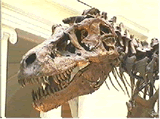 Tyrannosaurus
rex's jaws were up to 4 feet (1.2 meters) long and had 50 to 60 thick,
conical, bone-crunching teeth that ranged in size from very small to over
9 inches (23 cm) long. Adults had a variety of sizes of teeth in their
jaws at one time, as teeth were broken and new (smaller) ones grew in
to replace them. One Tyrannosaurus rex was found with some teeth up to
13 inch (33 cm) long. It could eat up to 500 pounds (230 kg's) of meat
and bones in one bite! Tyrannosaurus rex had a wrap-around overbite; when
it closed its mouth, the upper parts of the lower jaw's teeth fit inside
the upper teeth.
Tyrannosaurus
rex's jaws were up to 4 feet (1.2 meters) long and had 50 to 60 thick,
conical, bone-crunching teeth that ranged in size from very small to over
9 inches (23 cm) long. Adults had a variety of sizes of teeth in their
jaws at one time, as teeth were broken and new (smaller) ones grew in
to replace them. One Tyrannosaurus rex was found with some teeth up to
13 inch (33 cm) long. It could eat up to 500 pounds (230 kg's) of meat
and bones in one bite! Tyrannosaurus rex had a wrap-around overbite; when
it closed its mouth, the upper parts of the lower jaw's teeth fit inside
the upper teeth.
Tyrannosaurus rex was one of the largest terrestrial carnivores of all time. It stood approximately 15 feet high and was about 40 feet in length, roughly six tons in weight. Good Tyrannosaurus rex specimens, however, are hard to come by, Berkeley's mount is 90% complete, one of the best specimens found to date. Some 15–20 other specimens around the country range from about 10% to 80% complete; missing ribs and tail bones are common.
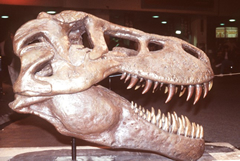
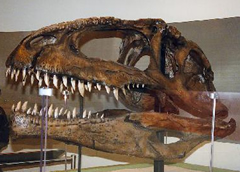
The skull on the left belongs to Tyrannosaurus rex, the skull to the right belongs to Giganotosaurus carolinii. The difference on their teeth is that Tyrannosaurus' were massive, like a railroad spike. Tyrannosaurus teeth were meant to crush and destroy its opponent. These teeth would go thru flesh and bone. Some of these teeth were as long as 12 inches. Its jaws were 16 times stronger than an alligator. Its teeth were solidly anchored to withstand pressure from every direction during an attack. On the other hand, Gigantosaurus teeth were smaller, they were designed more to slice and rip flesh from its victims. Even though Gigantosaurus may have been bigger and heavier than Tyrannosaurus rex, the title of the ultimate predator to ever walk the Earth belongs to Tyrannosaurus rex.
Tyrannosaurus had large visual lobes in its brain that processed visual information. Tyrannosaurus rex also had depth perception (since both eyes faced forwards on the front of its skull, and not placed on the sides), but it was not the only dinosaur that had depth perception. In general, predators (hunters) often have depth perception to help them hunt their prey. Animals that are hunted (like the plant-eating dinosaurs) usually have eyes located on the sides of their head (having no depth perception); this lets them see predators approaching from both sides. Tyrannosaurus rex's brain had a very large area in the brain for processing odors. Tyrannosaurus rex probably lived in forests, where its prey (plant-eating dinosaurs) could find plenty of food. Tyrannosaurus rex fossils have been found in western North America and Mongolia.
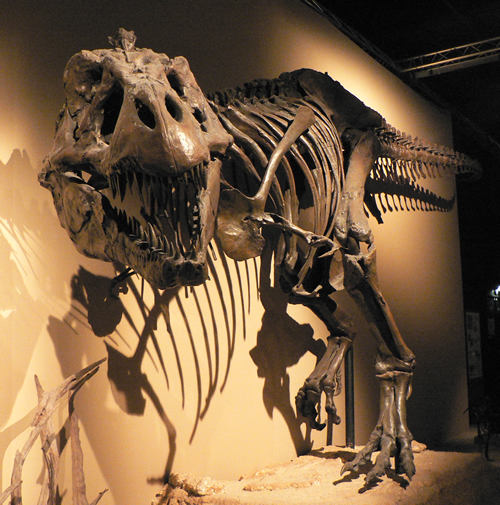
Discovery
About 30 incomplete Tyrannosaurus rex fossils have been found. One Tyrannosaurus
rex footprint has been found, in an undisclosed location in New Mexico,
USA. Fossilized T.rex dung has also been found. The first Tyrannosaurus
rex was first found by Barnum Brown in 1902, in Hell Creek, Montana, USA,
North America.
Tyrannosaurus rex Paleo Gallery
Click on images to see more art from artist!
